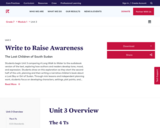Can we “find fuel for the future in the past”? Poet Nikki Grimes asks this question in her poem “Emergency Measures,” the first in her collection One Last Word: Wisdom from the Harlem Renaissance. As Grimes does in her book, students will spend the module pondering the wisdom from works created during the Harlem Renaissance. First students will explore scenes and songs from a play, poems, and artwork to experience the explosion of creativity and ideas of collaboration and innovation. Then students examine political artwork and cartoons, informative articles, and short stories to explore the social and political context of the Harlem Renaissance. Finally, students explore the legacy of the Harlem Renaissance, turning back to Nikki Grimes and her collection of poems crafted with lines from Harlem Renaissance poets. Students consider whether they and contemporary writers, singers, and musicians truly can “find fuel for the future in the past.”
In Unit 1, students explore collaboration in the Harlem Renaissance, noting how the Harlem Renaissance was an explosion and confluence of art, music, and literature. Students first examine scenes and songs from the Broadway musical Shuffle Along, experiencing this celebratory text that transformed American musical theater and was created through the collaboration of Eubie Blake, Noble Sissle, F. E. Miller, and Aubrey Lyles. Students analyze how the musical and textual techniques in the play affect meaning and develop themes such as love persevering through tough times. Similarly, students explore the thematic connections of triumph over hardships in the poem “Lift Every Voice and Sing” by James Weldon Johnson and the song and sculpture inspired by the text. Students then analyze iconic poems such as “The Negro Speaks of Rivers” by Langston Hughes, “Calling Dreams” and “Hope” by Georgia Douglas Johnson, and Claude McKay’s “I Shall Return.” In each of these poems, students analyze the structure, figurative language, and themes such as drawing strength from the past and overcoming adversity to fulfill one’s dreams. Students conclude their exploration of collaboration and cultural confluence in a collaborative discussion comparing McKay’s poem to artwork by Meta Warrick Fuller and Winold Reiss for thematic connections around drawing strength from and longing for home or Africa.
In Unit 2, students explore the social and political context of the Harlem Renaissance by reading short informational texts and examining visual art. Students learn how the Harlem Renaissance occurred during the era of the Great Migration, Jim Crow laws, and the racial violence of post-Civil War America. They then read two short stories, “His Motto” by Lottie Burrell Dixon and “The Boy and the Bayonet” by Paul Laurence Dunbar, analyzing point of view and the interactions between story elements, such as character, plot, and setting. Additionally, students discuss how both stories develop themes about working hard to achieve dreams and how community helps to bring out our best selves. Students continue their exploration of the Harlem Renaissance context by engaging with literary argument writing. Students examine a model literary argument essay then write pair and independent essays, discussing how three pieces of work from the Harlem Renaissance are connected by themes such as looking to the past for strength, collaboration and community to bring out one’s best self, and dreams giving life meaning and purpose.
In Unit 3, students explore the contemporary legacy of the Harlem Renaissance by examining short informational and literary texts, visual art, and performances to further develop their sense of how the Harlem Renaissance continues to impact us today. To develop their background knowledge about this legacy, students analyze Nikki Grimes’ poem “Emergency Measures,” original artwork associated with the poem, and Alvin Ailey American Dance Theater’s ballet, “Uptown,” which was inspired by the people, places, art, music, and writing of the Harlem Renaissance. Then students study several of Nikki Grimes’ poems in conjunction with the poetry of the Harlem Renaissance, learning how Grimes uses lines from poets such as Langston Hughes and Georgia Douglas Johnson to create her own poems which develop themes similar to those of the Harlem Renaissance but in a contemporary context. Students continue their exploration of the legacy of the Harlem Renaissance by creating a museum exhibit, which includes three pieces from the Harlem Renaissance and one contemporary piece that they have studied or created themselves. Students write a curator’s statement explaining how the works are connected by theme and create labels discussing the details of structure, language, and theme in each piece. Students practice and revise the presentation of their curator’s statements and labels preparing for the Harlem Renaissance museum, in which students contribute to making a better world by sharing these important works with their community.



